European cars have long been admired for their engineering prowess, design finesse, and overall allure. However, an intriguing paradox has emerged—the difference in perception of reliability between European cars in Europe and the US.
While Europeans generally vouch for the dependability of their homegrown automobiles, the same cannot always be said for their American counterparts. Delving into this phenomenon reveals many factors influencing this intriguing perception gap.
Cost of Parts and Maintenance
Parts and maintenance command the lion’s share of the budget of owning a vehicle. It determines the vehicle model that you finally purchase.
Across the Atlantic, European car parts tend to be pricier in the US, which may cause some owners to defer essential maintenance to cut costs. Unfortunately, this short-term gain may result in long-term consequences.
Minor issues may snowball into major problems over time. In contrast, European drivers are more inclined to follow meticulous maintenance schedules, preserving the overall health of their vehicles.
Disparity in Vehicle Inspection Standards
Of course, the amount of attention given to vehicles during the inspection is thought to vary between the US and Europe. For example, in Europe, there are two types of vehicle assessments: on-the-spot roadside inspections and periodic checks at a specialist center.
The EU law provides a basis for checking that vehicles throughout the member countries are roadworthy and are according to the same safety standards as when they were first registered.
In Europe, stringent inspections often catch potential problems early on, allowing for timely repairs and enhanced reliability. But vehicle inspections in the US tend to be less rigorous. For example, Fifteen states have an annual or biennial safety inspection program. This potentially lets issues go unnoticed until they become more significant concerns. This variation could lead to a contrasting perception of reliability.
Divergent Perspectives on the Role of European Vehicles
European drivers primarily view European-made vehicles as practical, everyday means of transport. Finding a European using the latest Mercedes model as a daily driver is not unusual. On the other hand, American consumers often associate them with luxury and prestige.
This perspective may tend to impose on vehicle owners’ consciousness regarding reliability. The idea is that prestigious vehicles have more features and technology, which may need more maintenance and costly repairs.




Recent Comments